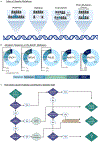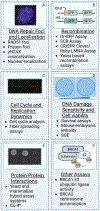Finding significance: New perspectives in variant classification of the RAD51 regulators, BRCA2 and beyond
- PMID: 37651978
- PMCID: PMC10529980
- DOI: 10.1016/j.dnarep.2023.103563
Finding significance: New perspectives in variant classification of the RAD51 regulators, BRCA2 and beyond
Abstract
For many individuals harboring a variant of uncertain functional significance (VUS) in a homologous recombination (HR) gene, their risk of developing breast and ovarian cancer is unknown. Integral to the process of HR are BRCA1 and regulators of the central HR protein, RAD51, including BRCA2, PALB2, RAD51C and RAD51D. Due to advancements in sequencing technology and the continued expansion of cancer screening panels, the number of VUS identified in these genes has risen significantly. Standard practices for variant classification utilize different types of predictive, population, phenotypic, allelic and functional evidence. While variant analysis is improving, there remains a struggle to keep up with demand. Understanding the effects of an HR variant can aid in preventative care and is critical for developing an effective cancer treatment plan. In this review, we discuss current perspectives in the classification of variants in the breast and ovarian cancer genes BRCA1, BRCA2, PALB2, RAD51C and RAD51D.
Keywords: BRCA1; BRCA2; Breast cancer; Homologous recombination; Homologous recombination deficient tumors; Ovarian cancer; PALB2; RAD51; RAD51C; RAD51D; Variant of unknown/uncertain significance.
Copyright © 2023 Elsevier B.V. All rights reserved.
Conflict of interest statement
Declaration of Competing Interest The authors declare that they have no known conflicts of interest that would influence the contents of this manuscript.
Figures




Similar articles
-
Homologous recombination-deficient mutation cluster in tumor suppressor RAD51C identified by comprehensive analysis of cancer variants.Proc Natl Acad Sci U S A. 2022 Sep 20;119(38):e2202727119. doi: 10.1073/pnas.2202727119. Epub 2022 Sep 13. Proc Natl Acad Sci U S A. 2022. PMID: 36099300 Free PMC article.
-
Comprehensive RAD51C ovarian cancer variant analysis uncouples homologous recombination and replicative functions.Nat Commun. 2025 Jul 16;16(1):6539. doi: 10.1038/s41467-025-61283-2. Nat Commun. 2025. PMID: 40670332 Free PMC article.
-
Breast cancer-associated missense mutants of the PALB2 WD40 domain, which directly binds RAD51C, RAD51 and BRCA2, disrupt DNA repair.Oncogene. 2014 Oct 2;33(40):4803-12. doi: 10.1038/onc.2013.421. Epub 2013 Oct 21. Oncogene. 2014. PMID: 24141787 Free PMC article.
-
Homologous recombination and human health: the roles of BRCA1, BRCA2, and associated proteins.Cold Spring Harb Perspect Biol. 2015 Apr 1;7(4):a016600. doi: 10.1101/cshperspect.a016600. Cold Spring Harb Perspect Biol. 2015. PMID: 25833843 Free PMC article. Review.
-
Homologous Recombination Deficiency: Cancer Predispositions and Treatment Implications.Oncologist. 2021 Sep;26(9):e1526-e1537. doi: 10.1002/onco.13829. Epub 2021 Jun 2. Oncologist. 2021. PMID: 34021944 Free PMC article. Review.
Cited by
-
Checkpoint and recombination pathways independently suppress rates of spontaneous homology-directed chromosomal translocations in budding yeast.Front Genet. 2025 Apr 4;16:1479307. doi: 10.3389/fgene.2025.1479307. eCollection 2025. Front Genet. 2025. PMID: 40255487 Free PMC article.
-
Germline variants in CDKN2A wild-type melanoma prone families.Mol Oncol. 2025 May;19(5):1493-1507. doi: 10.1002/1878-0261.70020. Epub 2025 Mar 12. Mol Oncol. 2025. PMID: 40072281 Free PMC article.
-
RAD51 and PALB2 in precision oncology: Clinical implications for HRD associated breast and ovarian cancers (Review).Int J Oncol. 2025 Aug;67(2):65. doi: 10.3892/ijo.2025.5771. Epub 2025 Jul 4. Int J Oncol. 2025. PMID: 40613200 Free PMC article. Review.
References
-
- Varol U, Kucukzeybek Y, Alacacioglu A, Somali I, Altun Z, Aktas S, Oktay Tarhan M, BRCA genes: BRCA 1 and BRCA 2, J BUON, 23 (2018) 862–866. - PubMed
-
- Miki Y, Swensen J, Shattuck-Eidens D, Futreal PA, Harshman K, Tavtigian S, Liu Q, Cochran C, Bennett LM, Ding W, et al., A strong candidate for the breast and ovarian cancer susceptibility gene BRCA1, Science, 266 (1994) 66–71. - PubMed
-
- Hall JM, Lee MK, Newman B, Morrow JE, Anderson LA, Huey B, King MC, Linkage of early-onset familial breast cancer to chromosome 17q21, Science, 250 (1990) 1684–1689. - PubMed
-
- Wooster R, Neuhausen SL, Mangion J, Quirk Y, Ford D, Collins N, Nguyen K, Seal S, Tran T, Averill D, et al., Localization of a breast cancer susceptibility gene, BRCA2, to chromosome 13q12-13, Science, 265 (1994) 2088–2090. - PubMed
-
- Fanale D, Pivetti A, Cancelliere D, Spera A, Bono M, Fiorino A, Pedone E, Barraco N, Brando C, Perez A, Guarneri MF, Russo TDB, Vieni S, Guarneri G, Russo A, Bazan V, BRCA1/2 variants of unknown significance in hereditary breast and ovarian cancer (HBOC) syndrome: Looking for the hidden meaning, Crit Rev Oncol Hematol, 172 (2022) 103626. - PubMed
Publication types
MeSH terms
Substances
Grants and funding
LinkOut - more resources
Full Text Sources
Medical
Research Materials
Miscellaneous

